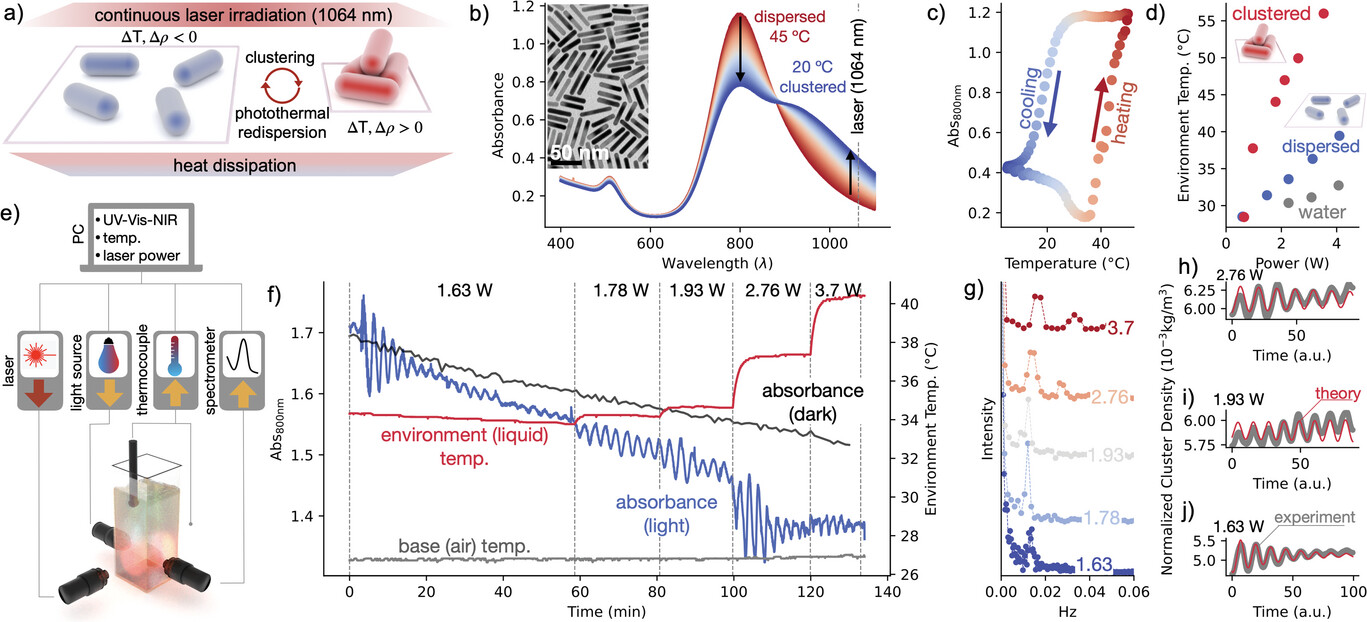Nanocolloids as hosts for light-propelled machineries
nanocolloids
The increasing attention to the design and experimental development of self-oscillating matter is primarily motivated by the potential use of such systems in emerging technologies (e.g., light engines) comprising compact components and minimum energy consumption.
Self-oscillation is the generation of a periodic change in a system fuelled by a steady, non-periodic power source. The ability of a self-oscillator to maintain its frequency and phase enables the conversion of a steady input into a usable oscillating output, a feature that is present in many biological systems (e.g. heart beating, neuron firing). Several synthetic materials based on liquid crystal networks, heterostructured biomorphs or nanoparticles-doped hydrogels have been proposed to elicit a self-sustained response under the continuous action of an external stimulus, such as light.
Typically, the emergence of self-oscillations requires macroscopic dimensions (a monolith) for the host system. The reaction at the atomic/molecular level to a given stimulus needs to prompt a large-scale dissipative process, which can modulate the stimulus effect by hampering at some point the growing response. This self-limiting feedback sustains coherent oscillatory patterns on a macroscopic scale, often detectable by the naked eye. Nanoscopic lengths are too small for such a mechanism to take place, thus explaining why clustering nanoparticles have been only used as colorimetric signal transducers for molecular oscillators, such as chemical reaction networks.
Soft composites of macroscopic dimensions are often doped with plasmonic nanoparticles to enhance energy dissipation and generate periodic response. However, while it is still unknown whether a dispersion of photonic nanocrystals may respond to light as a soft actuator, a dynamic analysis of nanocolloids self-oscillating in a liquid is also lacking.

Now, a team of researchers aims to answer 1 an important question, namely whether plasmonic nanoparticles—whose strong light absorption can turn them into highly efficient local heaters—may exhibit self-oscillatory clustering by conversion of light energy into local heat. They are known to sustain self-oscillating patterns in polymer and hydrogel materials (that is, soft-actuators or soft-robots) on a macroscopic scale. The team’s target, instead, is creating autonomous plasmonic systems, devoid of any macromolecular matrix that are capable to self-oscillate down to the nanometer scale.
To this purpose, the researchers develop a theory for energy and particle transport in an illuminated nanocolloidal dispersion. It predicts that the surface temperature of thermoplasmonic nanoparticles and the number density of their clusters jointly oscillate at frequencies ranging from infrasonic to acoustic values.
Experiments with spontaneously clustering gold nanorods under uninterrupted laser irradiation, where the photothermal effect alters the interplay of light (stimulus) with the disperse system on a macroscopic scale, agree with predictions.
By extending the theory to embrace increasing levels of nonlinearity, the team also detects the emergence of a new dynamic attractor, linking thermoplasmonics to nonlinearity and chaos.
These findings enlarge the current view on self-oscillation phenomena and anticipate the colloidal state of matter to be a suitable host for accommodating light-propelled machineries, paving the way for a nanoscale control of light-responsive processes.
Author: César Tomé López is a science writer and the editor of Mapping Ignorance
Disclaimer: Parts of this article may have been copied verbatim or almost verbatim from the referenced research paper/s.
References
- Mezzasalma, S. A., Kruse, J., Merkens, S., Lopez, E., Seifert, A., Morandotti, R., Grzelczak, M. (2023) Light-Driven Self-Oscillation of Thermoplasmonic Nanocolloids. Adv. Mater. doi: 10.1002/adma.202302987 ↩